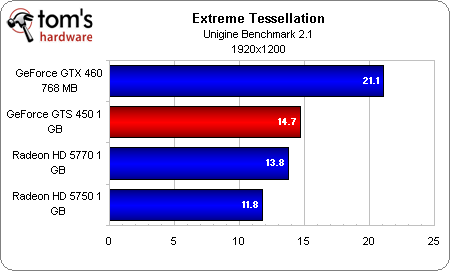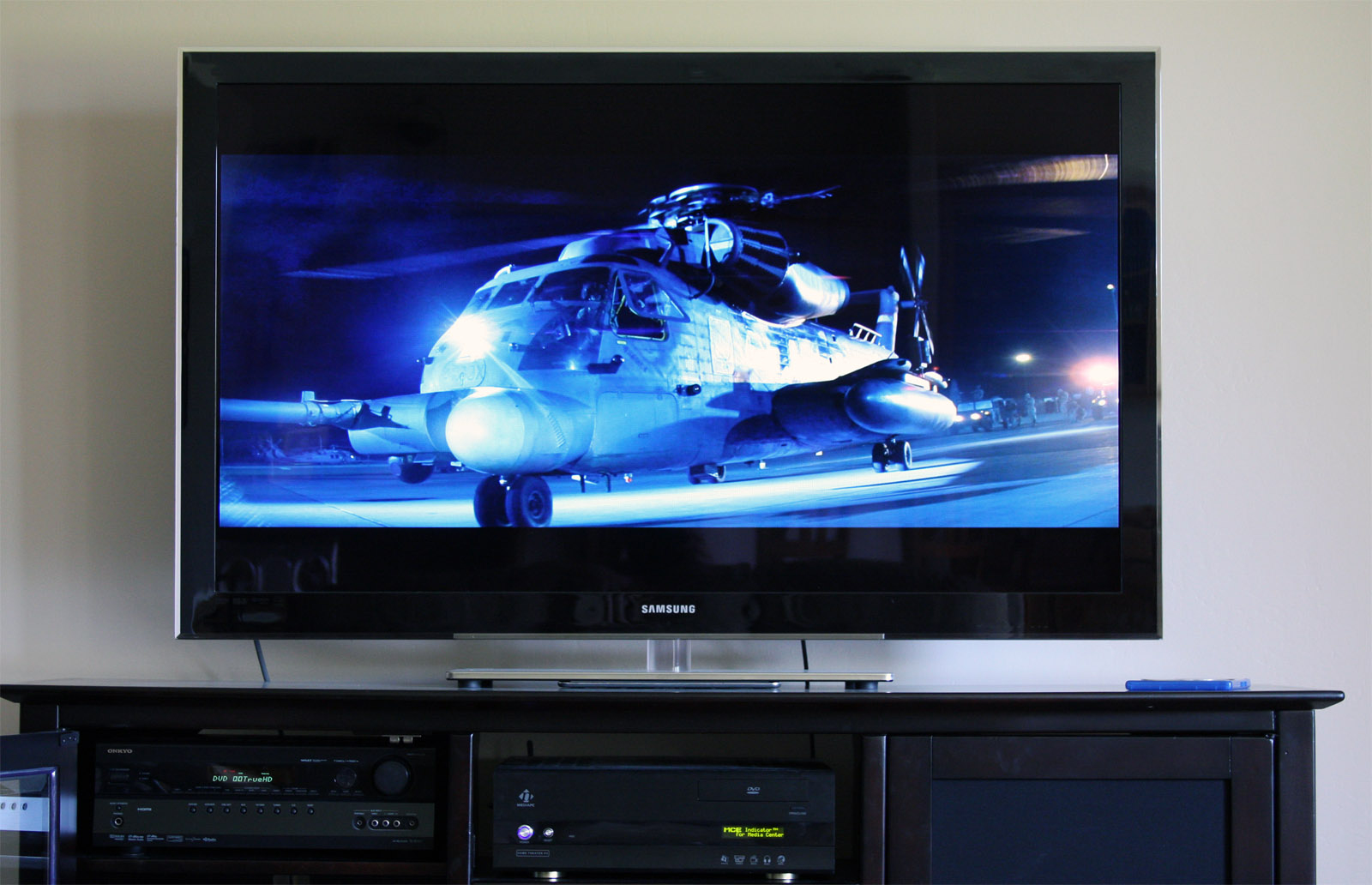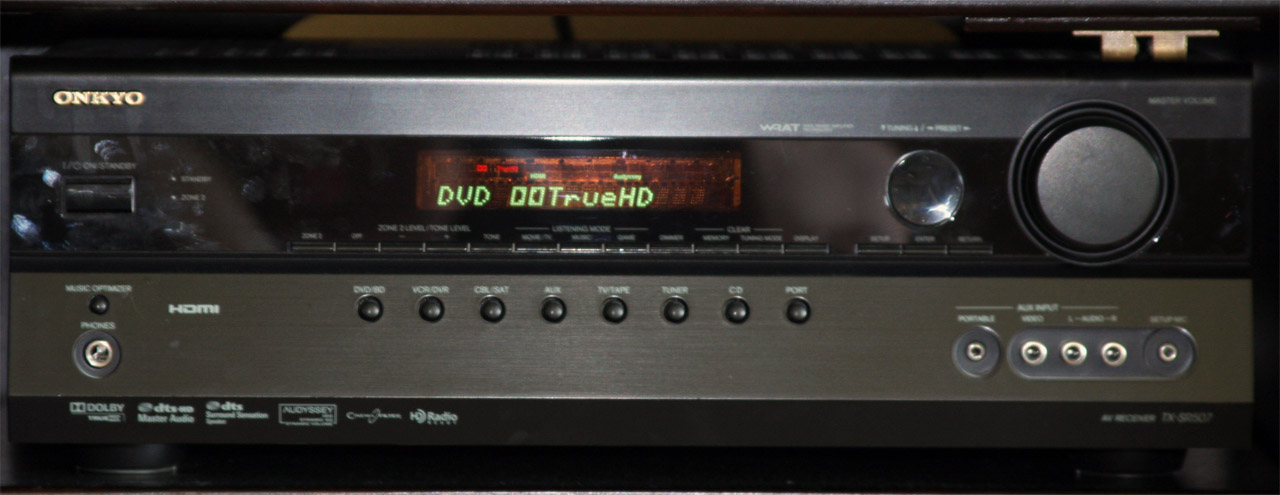Nvidia GeForce GTS 450: Hello GF106, Farewell G92
After dutifully serving the mainstream gaming community for three years, Nvidia's G92 is finally being played out. Meet GF106, the little engine behind GeForce GTS 450. Is this 192-core part still potent, or did Nvidia cut too much from G92's replacement?
Tessellation Performance And HTPC Potential
Geometry Performance
Over and over we hear Nvidia talk about its geometry performance, and how the Polymorph engine associated with each Shader Multiprocessor is going to allow the Fermi architecture to scale more aggressively as games begin incorporating more demanding implementations of tessellation.
Well, we still can’t put that claim to the test, because the few games out there right now with tessellation support don’t seem to tax Nvidia’s or AMD’s architectures very intensively. Nevertheless, I was curious how the GF106 GPU would handle the familiar Unigine benchmark with Extreme tessellation enabled. Does the fact that we’re now looking at a GPU with only four Polymorph engines inhibit reasonable geometry performance?
Although the GeForce GTS 450 is significantly slower than the GTX 460 768 MB, it’s also faster than either of AMD’s competing cards in this segment.
While the win is vindicating for the company putting an emphasis on geometry performance moving forward, you’re going to find that it doesn’t end up making much of a difference in today’s games. And while I as a technologist can appreciate the hardware foundation that must be built-up before software can evolve, Nvidia’s own engineers would have to agree that by the time we see Fermi’s geometric agility put to use, a GF106-based card is going to be dragging its feet.
Nevertheless, I really get a kick out of these little experiments anyway…
Bitstream Me Up, Scotty
Get Tom's Hardware's best news and in-depth reviews, straight to your inbox.
HTPC love. That’s what I was most excited about leading up to the GF106’s launch. I was actually hoping to see the GeForce GTX 460 enabled with bitstreaming support, but Nvidia wasn’t ready with a driver to complement its hardware two months ago. Now, with GeForce GTS 450, the company is pushing out its 260-series driver package that enables Dolby TrueHD and DTS-HD Master Audio output over HDMI.
Unfortunately, by the time I was wrapping this piece up to send to our international sites, CyberLink wasn’t quite ready with its updated version of PowerDVD 10. So, it looks like I’ve been foiled yet again.
At zero hour, Tom Vaughan, director of business development at CyberLink, swooped in to save the day with an early build of the PowerDVD 10 update that will be available to customers soon. Using that version of the software and Nvidia's 260.52 driver, I was able to get Zotac's GeForce GTX 460 card up and running with Onkyo's TX-SR507 receiver (GeForce GTS 450 employs the same updated VP4 video engine; GF100-based cards do not share this capability).
The good news is that I was able to get bitstreaming working on the first try (remember, it took a lot longer for AMD to get this same feature up and running). Transformers started up in multi-channel LPCM mode (with PowerDVD handling decoding), and with a simple drop-down menu adjustment, switched over to TrueHD.
Will you be able to tell the difference, aurally, in a movie like Transformers? Emphatically, no. I had to deliberately seek out The Police: Certifiable on Blu-ray to get a 24-bit/96 kHz soundtrack that'd outperform the standard 16-bit/48 kHz you get from LPCM anyway. And even then, it's debatable whether my Polk LSi speaker setup is good enough to reproduce the difference. I say all of this so that you have some perspective. For the big deal we make about bitstreaming, it takes good equipment and a trained ear to extrapolate any benefit from the capability over and above what you'd get from 7.1-channel LPCM (which is not lossless).
Current page: Tessellation Performance And HTPC Potential
Prev Page GF106: Nvidia Revisits The Mainstream Next Page SLI Is The Key-
welshmousepk Slightly underwhelming to be honest. the GTX 460 seems like a way better choice. or a 5770.Reply -
IzzyCraft Well now that it is competing with the 5750 maybe they will push both down to $100 and we wouldn't need to buy old G92 or R700's :DReply -
skora As Chris pointed out with Tessellation, DX11 isn't going anywhere fast with the programmers. I'd say still go for a 1gb 4850 or CF two and really have a powerful GPU subsystem for the $200-$220 price point. By the time they are aged, you'll have 2nd gen DX11 GPUs out and the software will finally be available to use them.Reply -
eklipz330 im still chuggin along on my hd 4850... and if i ever needed to, i can crossfire another one for a mere $90, these cards have been overpriced for a yearReply
its a shame that ati's cards didn't drop in MSRP. hell, the hd 5850 is finally approaching it;s MSRP of $250 from a year ago. I was hopign last year by around this time, hd 5870 would be ~$200... it's not even close = -
Jzcaesar Man, I was hoping to see some overclocking; hopefully, they'll be included in another article. But I agree with Chris: the 450 is a bit disappointing at $130.Reply -
sandypants Just bought a second 4870 1 GB to complete my CF setup which was planned 1.5 years ago. Only $130 from Newegg. 4870 vs 450 is not a tough choice if you are buying for a dedicated gaming rig. The 4000 series are still very adequate.Reply



